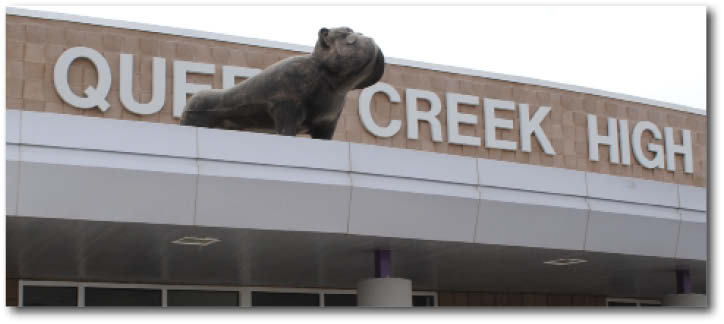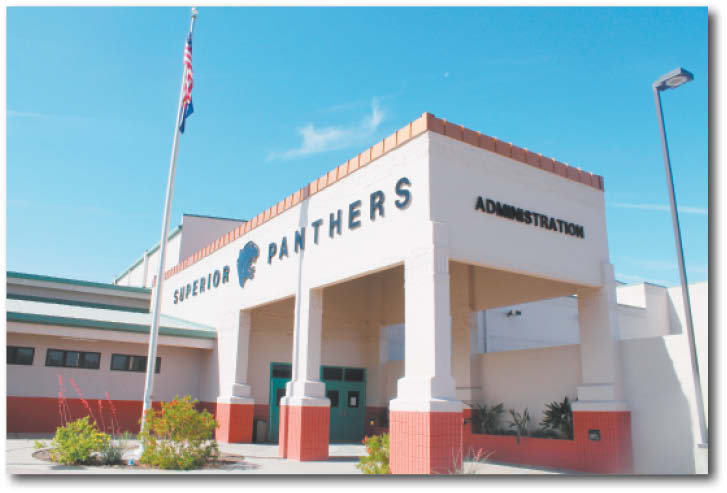
Queen Creek School District has seen enrollment drops due to charters in the area: EduPrize and Ben Franklin are two. Andrew Luberda | Ledger

Nearby Superior Unified School District hasn’t seen enrollment declining due to charter schools, but has had several students leave for religious schools on the voucher program. Mila Besich-Lira | Copper Area News
By James J. Hodl
Copper Area News
If it’s Fall in Arizona, it also is school budget override initiative season. And this year’s slate offered to voters in the north and east part of Pinal County includes override proposals for school districts in Queen Creek, Coolidge, Superior, Oracle and Kearny.
If such ballot initiatives seems to be coming with greater frequency, it is because voters in the recent down economy have been rejecting override requests, causing cash-strapped school districts to come back the next year to ask again. And this has led to weariness not only among voters but among school district administrators seeking to maintain the quality of education offered in their public schools and can get the necessary funds only through getting approval for budget overrides that are paid through increases in local property taxes.
According to Chuck Essigs, an executive with the Arizona Association of School Business Officials (AASBO), these early November dashes to the ballot box might not be needed if the state offered more equitable funding for public and charter schools. Arizona Legislature seems to favor charter schools over public schools when it comes to basic funding by providing charter schools with a higher per-pupil allocation than for public schools. During the 2013-14 school year, charter schools received basic per-pupil funding of $1,209 more ($5,053 for public school students in kindergarten through high school compared to $6,262 for charter students), according to statistics revealed by the Arizona Joint Legislative Budget Committee.
It is often claimed that Arizona lawmakers give charter schools a larger basic allocation because unlike public schools they cannot go to voters to get addition funding through a budget override. But that assumes that overrides are automatically approved by voters, which hasn’t been the case since 2008 when the economy went into a downturn.
The current funding system seems to be driving a wedge between schools and voters, said Dr. Amy Fuller, superintendent of Florence Unified School District (FUSD).
“I believe the current system places a tremendous burden on public schools and on the voters. If public school districts were funded equal to charters we would be receiving a minimum of $1,600 more per student. FUSD has 8,522 students. We would not want to go for an override if we could obtain that additional funding that charter schools do,” Fuller said.
“If there is no way to equalize the funding formula, then overrides should be for longer periods of time. That way public school districts could count on that funding for a longer period of time and make a significant difference in the lives of our students, faculty, staff, and communities,” she added.
FUSD is not going for an override this year, having had its proposal rejected in the previous two years.
Dennis Blauser, superintendent of the Oracle Elementary School District (OESD), agreed.
“It costs time and effort to get an override initiative on the ballot and to promote it to voters. That could be better spent on educational efforts in the schools,” Blauser said.
OESD, unlike most school districts in eastern Pinal County, does not have local competition from charter schools, but has seen some of its top students transferring to Basis in Oro Valley.
Patrick O’Donnell, superintendent of the Superior Unified School District (SUSD), said his schools have recently lost 24 students to vouchers. These students transferred mostly to religious schools but also a nearby school offering music education, which SUSD had to drop due to budget constraints.
“As the state funds schools on a per-pupil basis but the funding must cover all school expenditures, loss of a student means there will be fewer dollars to pay for things like teacher salaries, school maintenance and transportation,” O’Donnell said.
Charter school administrators, however, believe that charter schools are the ones being shortchanged.
“There are buckets of money available to public schools beyond the basic state allocations that charter schools cannot access,” complained Eileen B. Sigmund, CEO of the Arizona Charter School Association (ACSA). “These include access to property tax revenues, bonds, transportation stipends; so charters get less money to do their job.”
“This is because the legislature created School Choice but has opted not to fund School Choice,” she added.
“In addition to bond and override monies, public school districts have facilities board monies to build their buildings which charters do not. That means that a large percentage of charter funding must go toward providing a building whereas this is not the case for public district schools,” said Dr. Lynn Robershotte, administrator of EduPrize Schools, which operates a charter in Queen Creek.
“The monies that we receive are highly restricted, which means they must be spent on specific things/programs, etc. Charters are audited every year to ensure financial compliance. Overall, public school districts receive in excess of $1,600 more per student than charters,” she added.
This is borne out, she said, by the same Joint Legislative Budget Committee report which indicates that when all funding available to schools to totaled, public school districts have $8,992 per pupil to spend while charters have only $7,460 per pupil. This includes additional funding to public schools for maintenance and operations, school facilities, debt services, and federal funding for special needs programs. Charter schools get additional funding for general, federal, state and classroom site projects.
Public schools counter that some of these additional funds come from overrides, which are not a sure thing, especially those districts in lower income areas. (Some snide folks add that some school district overrides are failing because parents of charter school students are voting against them.)
Also some of these additional budget items are targeted federal funds to provide educational services from which charters are exempt under state law. These are the programs for students with special needs, are disabled or who need to learn English. Public schools also participate in the federal school lunch program and in some rural areas also provide breakfasts for some students.
Other advantages charter schools have over public schools is that charters can limit class size, noted AASBO’s Essigs. Public schools have to accommodate every student in its territory, even if it means classes with more than 40 students. And they have to accept students with learning disabilities.
Charter schools can expel students who fall behind classmates in a given subject. According to articles inThe Wall Street Journaland theWashington Post, it is not unusual for some for-profit charter schools to graduate eighth grade classes with only a third as many students as who enrolled in the fifth grade. Poor students getting the boot return to public schools, lowering achievement levels, the newspapers insinuated.
And while public schools have to be tuition free, charter schools that are short of funds can ask parents for donations, Essigs added.
Tired of pushing override initiatives to an increasingly less receptive citizenry, some school districts have opted to get increased basic budgets by converting public schools into charter schools. This gambit was pioneered by the school district in Cave Creek a few years ago and its success spawned others to go that route. This year alone, 24 public schools converted to charters; 11 of them in the Paradise Valley Unified School District alone. As some lawmakers feared this tactic would eventually bust the state education budget, legislation was enacted halting public to charter conversions. The same bill requires those schools that converted in the previous two years to return to public school status and funding levels.
At the time the legislation was introduced, FUSD was considering turning one of its schools into a district-run charter, Fuller said.
Both public school district and charter school administrators agree with one statement by ACSA’s Sigmund: “The 34-year-old Arizona system of school financing is broken and needs to be rebuilt.”
Low funding rates have prompted schools to get creative in how they spend what revenues they have. Some charter schools have banded together to locate bargains for school equipment. One found a warehouse of surplus desks in Flagstaff and snapped them up dimes on a dollar.
The biggest concern of schools beyond having to trim advanced programs and increase class sizes is the ability to retain and continue to attract quality teachers.
“Our teachers haven’t received a raise in seven years. They are doing an outstanding job and deserve to be rewarded,” said Sherry Dorothy, superintendent of the Miami Unified School District.
FUSD’s Fuller agreed, noting that when she first entered teaching 30 years ago her initial salary was $30,000 a year and that currently the average salary of a FUSD teacher is only $38,753 (the US average is $49,720). She added that in Pinal County 43 percent of teachers have left the county for better wages or simply leaving the profession. If nothing is done to correct the situation, the county will lose many great highly qualified teachers.
“Extra-curricular activities including sports, music, science clubs and others are expensive to run. Better technology is a great need and is not funded by the state. If we want our children to compete with the world, they need a global education, not a basic education,” Fuller said.
“Charters also are effected greatly by the reduction in state funding and budgeting restrictions,” EduPrize’s Robershotte said. “EduPrize has not reduced its special programs but instead provides state of the art technology labs, arts, science labs, and hands-on Live a Learning Labs where children go beyond basic instruction in the sciences to full application of content through creation and analysis of project based learning. While we greatly value low student to teacher ratios, we have had to add an average of two students per classroom to combat the financial cut backs.”
Other charter schools are likewise reporting a need for qualified teachers, though ads for positions don’t offer salaries much higher than public schools are offering.
For now, area school districts will concentrate on getting budget overrides enacted to bring their budgets up to at least par with charter schools in their areas. Queen Creek Unified School District (QCUSD) Superintendent Tom Lindsey said he was cautiously optimistic his district’s joint 15 percent override and construction bond issue campaign will succeed. Already with an “A” rating for its quality of education, Lindsey said that with the right level of support, QCUSD could have the best schools in the state.
But for the future, all districts are looking toward getting the Arizona legislature next year (when it will have about 30 percent new members) to approve higher basic budgets for all state-supported schools.
There also is interest in the court case where Judge Katherine Cooper ruled that the legislature violated the will of the voter in raising education expenditures by the rate of inflation or 2 percent annually as stipulated in Proposition 301, which was enacted in November 2000. Under the ruling, the state could be required to pay schools the difference between what they received has the legislature not reduced the education budget since 2009 and what they would have received if they followed Prop 301.
Education groups that spearheaded the lawsuit said they’d wave the back payments if the state would raise the level of funding to what it would have been currently under Prop 301 ($9,521 per pupil basic funding) for the coming school year. The state, however, is opting to appeal the decision.

